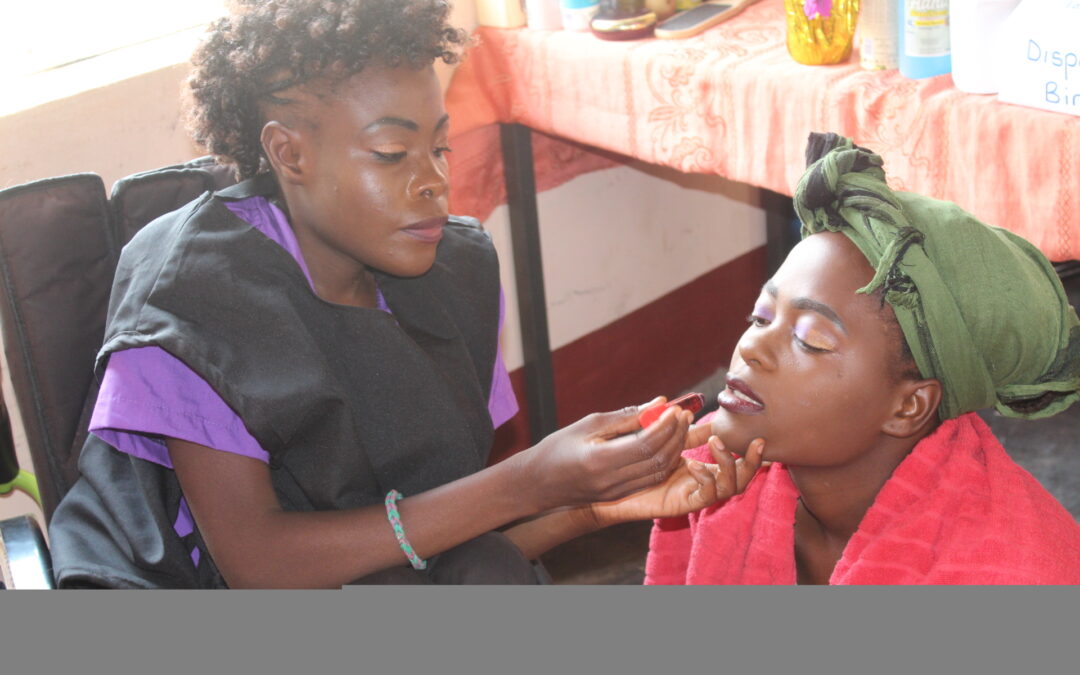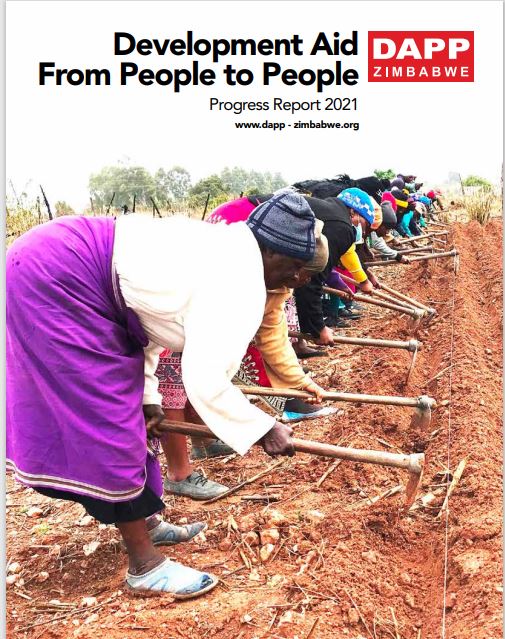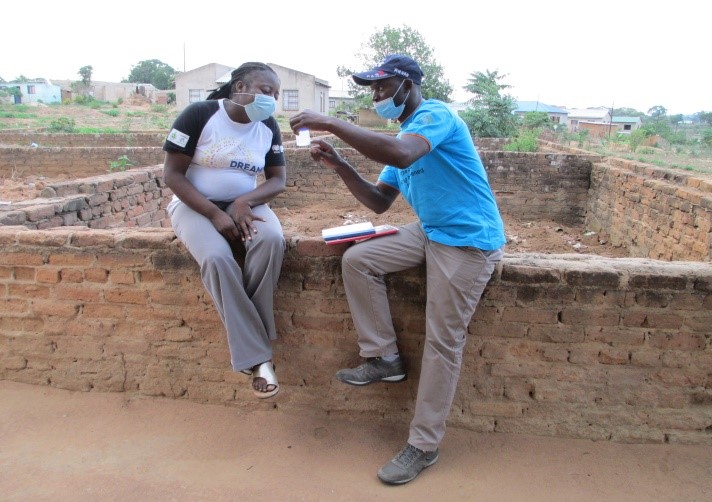
by ellen | Jan 26, 2023 | Blog, News
My name is Tatenda Maunde and I am a 22 year old young man from Mt Darwin. I wrote my form four in 2020 and passed six Ordinary Level subjects but due to financial constraints, I could not continue with my education. I had lost hope for the future.
I was introduced to vocational education training by a friend who had just completed short courses at Ponesai Vanhu Technical College (PVTC). I used to think that only students with lower grades were the ones placed in TVET schools but later on, I realized that those who graduates from such schools were getting opportunities since their skills were meeting market labour demands. I then made up my mind and enrolled for a Tourism and Hospitality long course at PVTC.
I got training on the baking business, making business plans, creating strong client base and social media marketing. Although I am looking forward to finishing my studies, I understand the high unemployment rate among young people in Zimbabwe. Therefore, our training is heavily centered on entrepreneurship skills training for self -employment and I hope to get together with other students to start our own bakery. I believe that there is need for vocational schools to engage industry experts as guests’ instructors to improve student’s skills in line with labour demands.
I want to call upon the Ministry of Higher and Tertiary Education to establish Youth Employment Clubs, where current students, graduates from different careers and company representatives to allow for continued learning and sharpening of critical soft skills, such as planning, negotiation, and communication.

by ellen | Nov 30, 2022 | Blog, News
Inequalities which perpetuate the AIDS pandemic are many and act as barriers to fighting AIDS the epidemic; we can tackle them. World AIDS Day, 1 December, theme: “Equalize” is drawing attention to addressing the HIV and AIDS challenges stumbling progress.
In Humana People to People, we have been and continue addressing the inequalities holding back progress to end AIDS by 2030. We have been part of fighting HIV and AIDS since 2000 and our efforts over the past two decades impacted 22 million people.
The world has only eight years left before the 2030 goal of ending AIDS as a global health threat. Economic, social, cultural and legal inequalities must be addressed as a matter of urgency. In a pandemic, inequalities exacerbate the dangers for everyone. The end of AIDS can only be achieved if efforts tackle the inequalities which drive it.
“We can end AIDS – if we end the inequalities which perpetuate it. This World AIDS Day we need everyone to get involved in sharing the message that we will all benefit when we tackle inequalities,” says UNAIDS Executive Director Winnie Byanyima. “To keep everyone safe, to protect everyone’s health, we need to Equalize.”
According to UNAIDS, globally 38.4 million people were living with HIV, 1.5 million acquired new HIV infection and 650 000 people lost life from AIDS-related illnesses in 2021. Every week, around 4 900 young women aged 15–24 years become infected with HIV. In 19 high-burden countries in Africa, dedicated combination prevention programmes for adolescent girls and young women are operating in only 40% of the high HIV incidence locations.
Data from UNAIDS on the global HIV response reveals that during the last two years of COVID-19 and other global crises, progress against the HIV pandemic has faltered, resources have shrunk, and millions of lives are at risk as a result. Four decades into the HIV response, inequalities still persist for the most basic services like testing, treatment, and condoms, and even more so for new technologies.
Our health projects focus on the biggest health challenges, among them to get Total control of the HIV and AIDS epidemic. Our HIV and AIDS programme Total Control of the Epidemic (TCE) is based on person-to-person mobilization of people for HIV testing, referral for treatment and support for those on treatment so that they never miss it.
In alignment with the UNAIDS 95-95-95 targets to end AIDS by 2030, our members help people to know and understand their HIV status. People who test HIV positive receive the sustained treatment they need, with the ultimate aim of suppressing the virus.
In the past year, TCE, operated by our member DAPP Zambia, mobilized and reached 334 342 people with HIV prevention messages and other HIV interventions. From the total people reached 76 796 were tested for HIV, 21 247 were diagnosed HIV+, and 98% of the people diagnosed with HIV were supported to start HIV treatment.
People living with HIV are more likely than others to become sick with TB. Worldwide, TB is one of the leading causes of death among people living with HIV. Without treatment, as with other opportunistic infections, HIV and TB can work together to shorten lifespan. Our TCE programme has been so successful that the method behind it is being used to detect cases of TB, and to support people infected with the disease to get treatment and complete it until they have been cured.
For the past 15 years, our member ADPP Mozambique has been implementing community-based TB projects in cooperation with the Ministry of Health impacting 1 million people every year. A major focus of TB response is on TB prevention, active TB case finding, contact tracing, adherence to medication and treatment completion.
World AIDS Day remains as relevant today as it’s always been, reminding people and governments that HIV has not gone away. All of us, everywhere, must do all we can to help tackle AIDS inequalities.

by ellen | Jul 18, 2022 | Blog, News
My name is Esnath Nyabadza and I am a 24-year-old young woman farmer from Ward 19 Moyoweshumba village in Mutasa District. I am a member of DAPP Farmers’ Clubs where I am learning conservation farming, smart agriculture and rearing of small livestock for improved food security, nutritional health and income.
I participated in DAPP demonstration plots on conservation farming where I learnt different techniques such as mulching, potholing, intercropping and the use of manure. From each of these techniques, I learnt a hands-on skill and how it promotes crop growth. The demonstration plots were my classroom and I replicated everything in my fields.
My production increased from getting five bags of maize to 14 which is enough for my family till the next harvesting season. I am even selling excess produce at the local marketplace and use the money to buy basic commodities. Budget lessons taught me the best ways to spend and save money something which is helping in boosting my other projects. I hope to continue producing more and expand my market linkages. However, there is very little to none in terms of support given by local government authorities to position local smallholder farmers well so that they can compete with large-scale farmers and imports. The trade imbalance is more acute for certain kinds of agricultural produce. There is, therefore, a need to encourage and enforce local content by laws tailored for the benefit of local women and smallholder farmers. The Local Content Strategy (LCS) is a strategy that can be used to encourage local value addition through localization of supply chains. It is my hope that the strategy will create economic linkages and business opportunities for local entrepreneurs. However, there is a need to implement a local project that focuses on market linkages and specifically identifies value chain roles that can attract youth to be active participants in local agricultural value chains. Looking to the future, I hope to see more women access new markets through group selling within Farmers’ Clubs and linkages to agricultural value chains. The DAPP model is one such model which can assist us with market linkages. I implore the Ministry of agriculture and food security and other relevant partners such as DAPP to continue supporting smallholder youth farmers with linkages to financial service providers that support women’s agriculture activities.

by ellen | Jul 1, 2022 | Blog, News
My name is Tarisai Mashanga and I am a 24-year-old young woman living with a disability. I come from Chipadze in Bindura District where I live with my unemployed grandmother. Being born with a disability made me a charity case relying on well-wishers. In academics, I ended at form two due to lack of finances, inaccessible learning environment for persons with disability and discrimination. Due to my little exposure, I had no means of making a living.
In 2019 I participated in Youth with Disability (YWD) networking groups established by Development Aid from People to People (DAPP) and Leonard Cheshire Disability Zimbabwe (LCDZ). Through these networks, we learnt more about our rights in line with the United Nations Convention on the Rights of Persons with Disabilities (CRPD), and entrepreneurship skills training to enhance livelihood opportunities. With help from my ward Councilor and Social Welfare, I was awarded a scholarship to study Beauty Therapy at Ponesai Vanhu Technical College (PVTC).
Being at PVTC helped to build my confidence and networking skills. Apart from my main line, I gained extra skills in creating a business plan, computer literacy skills and marketing skills. Finding attachment was not easy as few salon owners didn’t accommodate people with disabilities. However, through assistance from DAPP, I secured a place and I started building my client base. On graduation, I received a start-up kit and am renting a chair in one salon in Bindura Town. I also make house calls for hairdressing. I have moved from the charity case to the self– reliant mode and my dream is to be a renowned beauty therapist in Bindura. I am also now able to support my unemployed grandmother, who has been supporting me since my childhood.
I hope to see other youths with disabilities accessing scholarships for skills training at vocational training centers. I wish to see more investments in education and skills development through the establishment of more Vocational Training Centers in Zimbabwe.
I also appeal both to the Government through its relevant ministries like Ministry of Youths, Sports, Arts and Culture; Ministry of Women, Small and Medium Enterprise Development and developmental partners, e.g., DAPP, to join hands and capacitate Youth with Disabilities. This is because active engagement of Youth in sustainable development efforts, especially us with Disabilities, is central to achieving sustainable, inclusive and stable societies, thus averting our worst threats of being sexually abused. For the other Youths, this averts various social ills which include drug abuse, prostitution as well as reduces unemployment while promoting gender equality. Thus, there is a need for decentralized business networking hubs with supporting equipment and machinery for youths to be economically active at low cost. In addition, more grant allocation should be channeled towards youth entrepreneurship activities.

by dapp | Jun 9, 2022 | Blog, News
We are excited and proud to release our Development Aid from People to People Report 2021.
The report highlights the work and results of our collective efforts as we pursue our mission of implementing the most needed projects, identified through community engagements with the people. In 2021 Development Aid from People to People reached more than 150,000 people through 12 development projects within Health, Agriculture, Education, Community Development and Emergencies, in Mashonaland Central, Manicaland and Masvingo provinces.
We take this opportunity to extend a big THANK YOU to different sectors, including the Government of Zimbabwe, the private sector, embassies, communities as well as individuals who supported the work of enhancing people’s capacities through quality community led projects.
Development Aid from People to People Report 2021.

by dapp | Mar 24, 2022 | Blog, News
As Humana People to People and its members mark World Tuberculosis Day, we are spotlighting the work of our Total Control of TB Program. The model delivers health services directly to hard-to-reach people, whether in the cities or rural areas.
Part of our programme model is to meet people at their doorstep with information about TB, provide them with the opportunity to receive TB screening, collect samples and deliver them to the laboratories for analysis.
This helps us treat people as early as possible and improves the provision of quality TB services and treatment achievement rates.
Humana People to People is implementing Total Control of TB Programs in Angola, Mozambique, Malawi, Democratic Republic of Congo, Guinea Bissau, Zimbabwe and Laos. Most of the programs are targeting early TB detection, referral for TB treatment, support for adherence treatment and care.
Several of the TB programs integrate creation of community network support linkages with health centres and investment in modern scientific equipment which help to detect resistant TB including Multi-Drug Resistant TB at local clinics and district hospitals.
Humana People to People is supporting the theme – “Invest to End TB. Save Lives” which conveys the urgency to invest in the provision of resources required to improve the fight against TB and achieve the commitments to end TB made by global leaders.
Talking about the progress of TB programs, Snorre Westgaard, Chairperson of Humana People to People said:
“Now more than ever, the world needs programmes that have been tried and tested in communities in Africa and Asia. The race to end the TB epidemic belongs to everyone, and the centre of our TB response program shows the success of models that are community-driven, people-centred and offer locally-led results.
“We put resources into the human capacity building – healthcare professionals and community project activists, infrastructure investment in advanced TB diagnostic machinery at local clinics and district hospitals, and creating synergies between communities and health institutions.”






